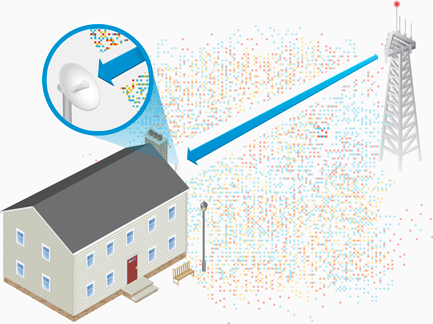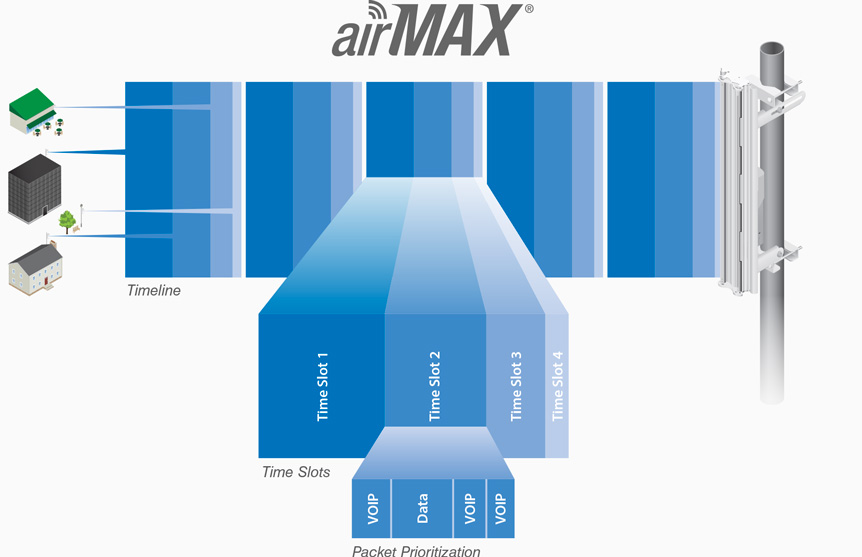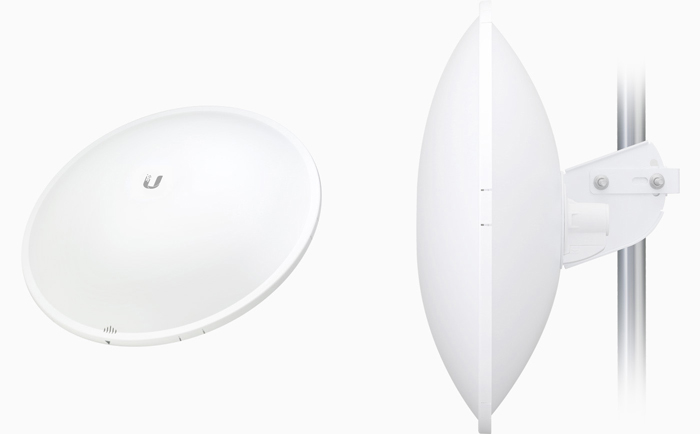Ubiquiti airMAX 5 GHz PowerBeam, airMAX 400 mm – PBE-M5-400
For The Immediate delivery requirement contact sales team. Usually Ship in 2-3 days Back to Back 4-5 Weeks, images are for illustration purposes only
AED 371.00 excl. VAT
Out of stock product
Ubiquiti airMAX 5 GHz PowerBeam, airMAX 400 mm – PBE-M5-400
Overview
Starting with the first-generation NanoBridge, Ubiquiti Networks pioneered the all-in-one design for an airMAX product functioning as a CPE (Customer Premises Equipment). Now Ubiquiti Networks launches the latest generation of CPE, the PowerBeam.
Improved Noise Immunity
The PowerBeam directs RF energy in a tighter beamwidth. With the focus in one direction, the PowerBeam blocks or spatially filters out noise, so noise immunity is improved. This feature is especially important in an area crowded with other RF signals of the same or similar frequency.
Integrated Design
Ubiquiti’s InnerFeed technology integrates the radio into the feedhorn of an antenna, so there is no need for a cable. This improves performance because it eliminates cable losses.
Providing high performance and innovative mechanical design at a low cost, the PowerBeam is extremely versatile and cost-effective to deploy. airMAX Technology Included
Unlike standard Wi-Fi protocol,
Ubiquiti’s Time Division Multiple
Access (TDMA) airMAX protocol
Application Examples
The PowerBeam used as a CPE device for each client in an airMAX PtMP network.
Use a PowerBeam on each side of a PtP link.
allows each client to send and receive data using pre-designated time slots scheduled by an intelligent AP controller.
This time slot method eliminates hidden node collisions and maximizes airtime efficiency. It provides significant performance improvements in latency, throughput, and scalability compared to all other outdoor systems in its class.
Intelligent QoS Priority is given to voice/video for seamless streaming.
Scalability High capacity and scalability.
Long Distance Capable of high-speed, carrier-class links.
airMAX TDMA Technology
Up to 100 airMAX stations can be connected to an airMAX Sector; four airMAX stations are shown to illustrate the general concept.
Software
airOS® is an intuitive, versatile, highly developed Ubiquiti firmware technology. It is exceptionally intuitive and was designed to require no training to operate. Behind the user interface is a powerful firmware architecture, which enables high-performance, outdoor multi-point networking.
- Protocol Support
- Ubiquiti Channelization
- Spectral Width Adjustment
- ACK Auto-Timing
- AAP Technology
- Multi-Language Support
Integrated on all Ubiquiti M products, airView® provides advanced spectrum analyzer functionality: waterfall, waveform, and real-time spectral views allow operators to identify noise signatures and plan their networks to minimize noise interference.
- Waterfall Aggregate energy over time for each frequency.
- Waveform Aggregate energy collected.
- Real-time Energy is shown in real time as a function of frequency.
- Recording Automate airView to record and report results.
airControl® is a powerful and intuitive, web-based server network management application, which allows operators to centrally manage entire networks of Ubiquiti devices.
- Network Map
- Monitor Device Status
- Mass Firmware Upgrade
- Web UI Access
- Manage Groups of Devices
- Task Scheduling
Hardware Overview
Innovative Mechanical Design
- Built-in mechanical tilt The mounting bracket conveniently offers 20° of uptilt and up to 20° of downtilt.
- Quick assembly The number of fasteners was reduced to simplify assembly. Tools are required only when the technician mounts the PowerBeam on the pole.
- Easy removal The antenna feed can be detached with the push of a button.
Specification
PBE-M5-400 |
|||||
| Dimensions | 420 x 420 x 275 mm (16.54 x 16.54 x 10.83″) | ||||
| Weight | 1.753 kg (3.87 lb) | ||||
| Power Supply | 24V, 0.5A Gigabit PoE | ||||
| Max. Power Consumption | 8W | ||||
| Operating Frequency | Worldwide | USA: U-NII-1 | USA: U-NII-2A | USA: U-NII-2C | USA: U-NII-3 |
| 5150 – 5875 MHz | 5150 – 5250 MHz* | 5250 – 5350 MHz* | 5470 – 5725 MHz* | 5725 – 5850 MHz* | |
| Gain | 25 dBi | ||||
| Networking Interface | (1) 10/100/1000 Ethernet Port | ||||
| Processor Specs | Atheros MIPS 74Kc, 560 MHz | ||||
| Memory | 64 MB DDR2, 8 MB Flash | ||||
| LEDs | (1) Power, (1) LAN, (4) WLAN | ||||
| Signal Strength LEDs | Software-Adjustable to Correspond to Custom RSSI Levels | ||||
| Max. VSWR | 1.5:1 | ||||
| Channel Sizes | 5/8/10/20/30/40 MHz | ||||
| Polarization | Dual Linear | ||||
| Enclosure | Outdoor UV Stabilized Plastic | ||||
| Mounting | Pole-Mount (Kit Included) | ||||
| Wind Loading | 278.4 N @ 120 km/h (63 lbf @ 75 mph) | ||||
| Wind Survivability | 120 km/h (75 mph) | ||||
| ESD/EMP Protection | Air: ± 24 kV, Contact: ± 24 kV | ||||
| Operating Temperature | -40 to 70° C (-40 to 158° F) | ||||
| Operating Humidity | 5 to 95% Noncondensing | ||||
| Wireless Approvals | FCC, IC, CE | ||||
| RoHS Compliance | Yes | ||||
| Salt Fog Test | IEC 68-2-11 (ASTM B117), Equivalent: MIL-STD-810 G Method 509.5 | ||||
| Vibration Test | IEC 68-2-6 | ||||
| Temperature Shock Test | IEC 68-2-14 | ||||
| UV Test | IEC 68-2-5 at 40° C (104° F), Equivalent: ETS 300 019-1-4 | ||||
| Wind-Driven Rain Test | ETS 300 019-1-4, Equivalent: MIL-STD-810 G Method 506.5 | ||||
PBE-M5-400 Output Power: 26 dBm |
||||||||
| TX Power Specifications | RX Power Specifications | |||||||
| Data Rate | Avg. TX | Tolerance | Data Rate | Sensitivity | Tolerance | |||
| 6 – 24 Mbps | 26 dBm | ± 2 dB | 6 – 24 Mbps | -94 dBm Min. | ± 2 dB | |||
| 36 Mbps | 25 dBm | ± 2 dB | 36 Mbps | -80 dBm | ± 2 dB | |||
| 48 Mbps | 24 dBm | ± 2 dB | 48 Mbps | -77 dBm | ± 2 dB | |||
| 54 Mbps | 23 dBm | ± 2 dB | 54 Mbps | -75 dBm | ± 2 dB | |||
| MCS0 | 26 dBm | ± 2 dB | MCS0 | -96 dBm | ± 2 dB | |||
| MCS1 | 25 dBm | ± 2 dB | MCS1 | -95 dBm | ± 2 dB | |||
| MCS2 | 25 dBm | ± 2 dB | MCS2 | -92 dBm | ± 2 dB | |||
| MCS3 | 25 dBm | ± 2 dB | MCS3 | -90 dBm | ± 2 dB | |||
| MCS4 | 24 dBm | ± 2 dB | MCS4 | -86 dBm | ± 2 dB | |||
| MCS5 | 23 dBm | ± 2 dB | MCS5 | -83 dBm | ± 2 dB | |||
| MCS6 | 23 dBm | ± 2 dB | MCS6 | -77 dBm | ± 2 dB | |||
| MCS7 | 23 dBm | ± 2 dB | MCS7 | -74 dBm | ± 2 dB | |||
| MCS8 | 26 dBm | ± 2 dB | MCS8 | -95 dBm | ± 2 dB | |||
| MCS9 | 25 dBm | ± 2 dB | MCS9 | -93 dBm | ± 2 dB | |||
| MCS10 | 25 dBm | ± 2 dB | MCS10 | -90 dBm | ± 2 dB | |||
| MCS11 | 25 dBm | ± 2 dB | MCS11 | -87 dBm | ± 2 dB | |||
| MCS12 | 24 dBm | ± 2 dB | MCS12 | -84 dBm | ± 2 dB | |||
| MCS13 | 23 dBm | ± 2 dB | MCS13 | -79 dBm | ± 2 dB | |||
| MCS14 | 23 dBm | ± 2 dB | MCS14 | -78 dBm | ± 2 dB | |||
| MCS15 | 23 dBm | ± 2 dB | MCS15 | -75 dBm | ± 2 dB | |||















































Reviews
There are no reviews yet.